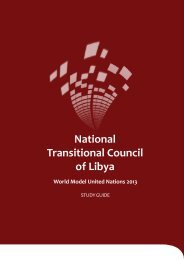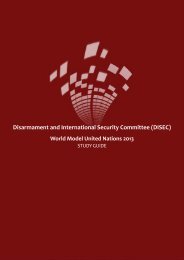INTERPOL - World Model United Nations
INTERPOL - World Model United Nations
INTERPOL - World Model United Nations
Create successful ePaper yourself
Turn your PDF publications into a flip-book with our unique Google optimized e-Paper software.
species list from extinction. In particular, resurges of<br />
alligator, crocodile, rhinoceros, and elephant populations<br />
around the world are credited in large part to CITES’<br />
eorts. 20<br />
However, CITES can only go so far in reversing species<br />
degradation without the cooperation of domestic law<br />
enforcement agencies. Much needs to be done to transfer<br />
the international scientic and management expertise on<br />
wildlife crime control to regional and local bodies. As an<br />
example, CITES banned trade in rhino horns as early as<br />
1977 and ivory in 1983, 21 yet the practice of ivory trade<br />
still continued ourishing, destroying 97% of rhinoceros<br />
species and 90% of elephant populations by the 1990s. 22<br />
Izgrev Topkov, former Secretary-General of CITES, has<br />
encapsulated the issue quite succinctly: “CITES establishes<br />
only the framework whereby the participating countries to<br />
the Convention have agreed to regulate international trade<br />
in certain species of wild animals and plants. e practical<br />
aspects of creating an infrastructure to control this trade<br />
are le up to the countries concerned. It is no secret that<br />
traditional enforcement methods have largely failed for the<br />
protection of some African species.” 23 When discussing the<br />
benets of CITES, it is important for <strong>INTERPOL</strong> members<br />
to keep its shortcomings in mind in order to best address<br />
how to improve its implementation and realization.<br />
Part of an August 2007 seizure in Russia of 480 bear paws,<br />
a Siberian tiger pelt and bones, and 20 kg of wild ginseng,<br />
all destined for China. e smuggling gang involved received<br />
jail sentences of up to 8 years. (http://www.cawtglobal.org/<br />
wildlife-crime)<br />
In 1994, experts from nine Southern and Eastern<br />
African nations met in Nairobi, Kenya, to set up the<br />
1.2 What new-found indicators point to poaching<br />
as a syndicated crime?<br />
-Increased use of gangs, vehicles, weapons, and ammunition<br />
-Violence against law enforcement personnel<br />
-Corruption of law enforcement personnel using<br />
monetary or sexual bribes, blackmail, and other<br />
means<br />
-Exploitation of civil unrest<br />
-Financial investment into processing and marketing<br />
-Attitude of “inviolability” of those involved<br />
-Sophistication of smuggling routes and techniques<br />
-Use of “mules” and couriers<br />
-Sophisticated forgery and counterfeiting of documents<br />
-Fraudulent advertising for wildlife parts on the<br />
Internet<br />
-Connection of known organized crime group<br />
members to poaching<br />
-Huge prots in a short time—a known factor in the<br />
history of organized crime<br />
rst international African Task Force on illegal wildlife<br />
tracking. is agreement stems from a 1992 initiative<br />
from Lusaka, Zambia titled Co-Operative Enforcement<br />
Operations Directed at Illegal Trade in Wild Flora and<br />
Fauna. eir initiative is a regional attempt to crack down<br />
on smuggling syndicates whose operations go beyond<br />
the reach of any national Law Enforcement Organization<br />
(LEO). e Task Force meets annually and consists of<br />
Kenya, Lesotho, Malawi, Mozambique, South Africa,<br />
Swaziland, Tanzania, Uganda, and Zambia, along with<br />
international donors and activists from CITES, <strong>INTERPOL</strong>,<br />
and the US Fish and Wildlife Service. 24 Such regional<br />
eorts are commendable and stand to be replicated in other<br />
areas of the world.<br />
PRESENT RELEVANCE<br />
Today, wildlife crime is becoming increasingly more<br />
sophisticated and organized (see box) due to advances<br />
in technology, transportation, and regional conict.<br />
Wildlife crime is now a signicant factor -- alongside<br />
habitat destruction, pollution, and exploitation -- in the<br />
decline of species around the world. 25 As an example,<br />
rhinoceros poaching has increased dramatically this year,<br />
Harvard <strong>World</strong>MUN 2012 <strong>INTERPOL</strong> 9

















